It would be fair to say that the 2018/19 Championship season was less than auspicious for Ipswich Town. The Tractor Boys finished bottom of the pile with just 31 points having only accrued five wins across the entire season. However, it shouldn’t be considered total doom and gloom for Ipswich. Throughout the season given budgetary constraints compared to their rivals in the division, Ipswich were able to give established first-team roles to some of their academy graduates. Myles Kenlock continued his footballing development as he earned over 1600 minutes on the field. England U20 international Andre Dozzell was handed around 900 first team minutes in midfield. However, the academy graduate who played the most minutes for Ipswich last season was 20-year-old Flynn Downes who played over 1800 minutes in midfield.
In this tactical analysis, we will look at Flynn Downes’ style of play both with the ball and without and with the help of statistics, we will aim to provide a comprehensive analysis and scout report on the player.
On the ball
Flynn Downes, more often than not, operated on the left or right-hand side of a central midfield three for Ipswich this season. His role tended to be that of a box-to-box midfielder as he was required to not only positively affect the game in the final third, but was tasked with tracking back and helping out the defensive midfielder Trevoh Chalobah and the Ipswich defence.
In a struggling team that only managed 36 goals last season, it can be difficult to stand out offensively. However, the signs that Flynn Downes has an impressive creative ability are there. He averaged 37 passes per 90 minutes with a commendable accuracy of 81.9%. Downes played 5.26 progressive passes per 90 minutes which is the 77th most of players in a similar position in the Championship with at least 1500 minutes. Whilst 77th may seem low, he ranks above the likes of Jay Fulton, who plays for possession-hungry Swansea and only marginally behind the likes of Jack Grealish, John McGinn and Mason Mount. In addition to this, Flynn Downes made 0.5 deep completions per 90 last season ranking him 75th in this metric. Again 75th seems a low total but he ranks just above his teammate Chalobah, who is tipped to have a bright future, as well as above the likes of Trybull and Tettey of Norwich and Kalvin Phillips of Leeds. He is incredibly accurate with his deep completions as he makes 90% of these which ranks him as 31st in the division. This ranks Downes ahead of the likes of Mateusz Klich of Leeds, Mark Duffy of Sheffield United and Connor Hourihane of Aston Villa. These statistics are reflected in Flynn Downes’ game.
Flynn Downes tends to be most effective when looking to play passes into the channels for onrushing teammates.
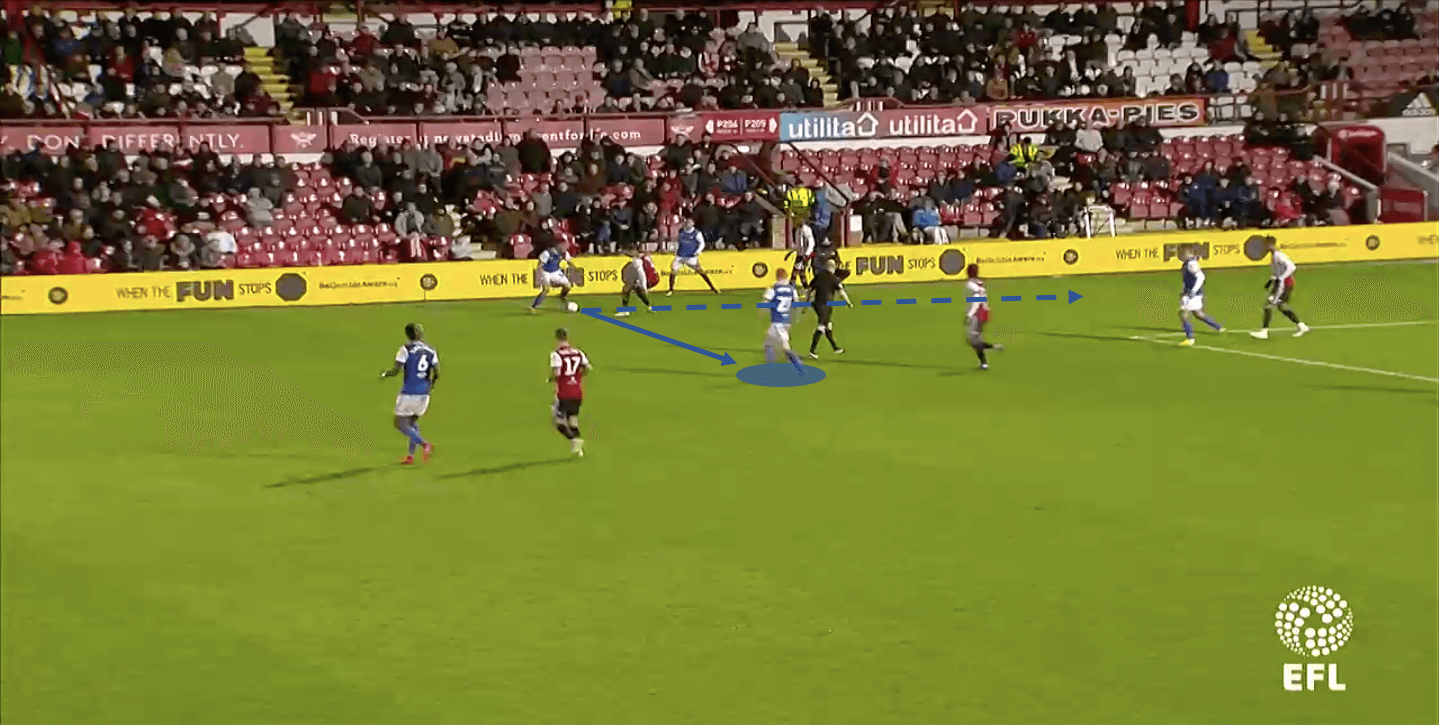
He often combines effectively with a wide-man with one-twos to free his teammate down the wing and into space to cross.
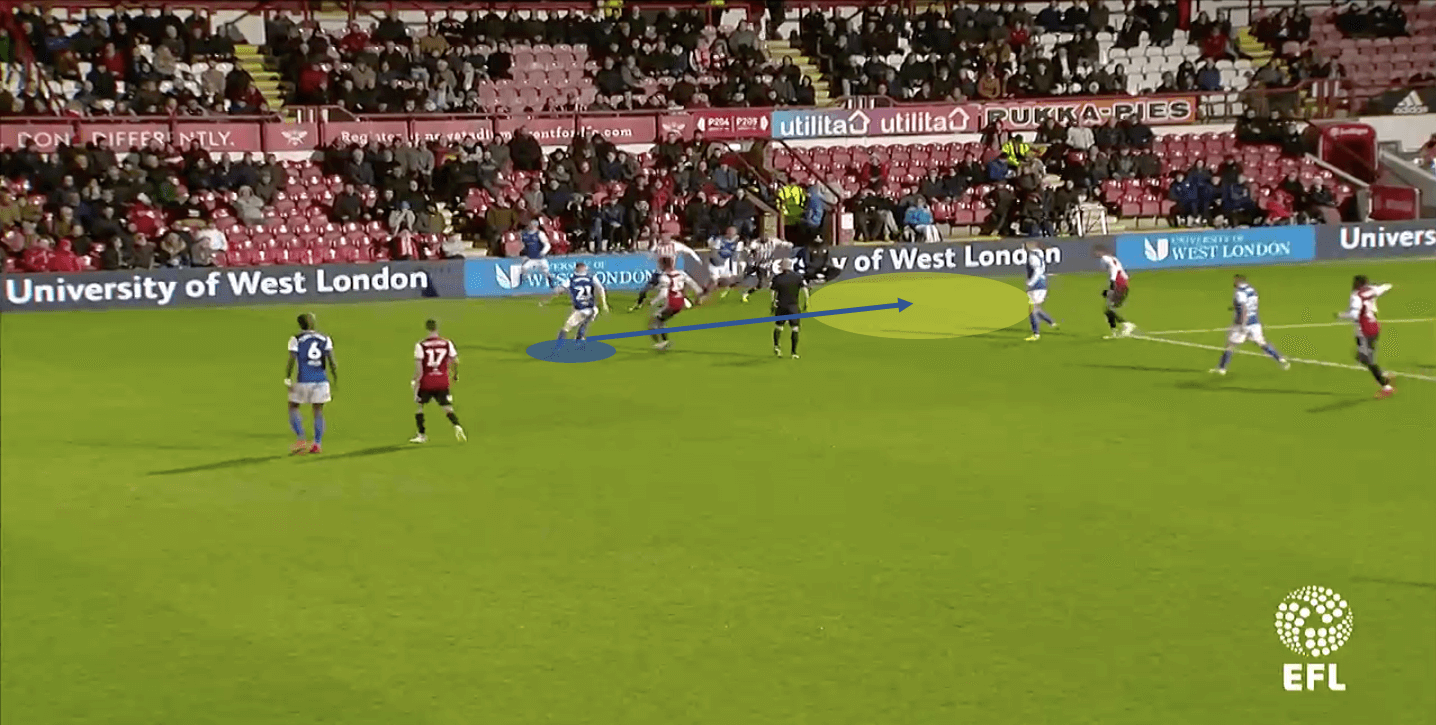
In the example above from a game against Brentford, Downes plays a first-time return pass with the outside of his boot into the space between winger and full-back releasing his teammate down the line.
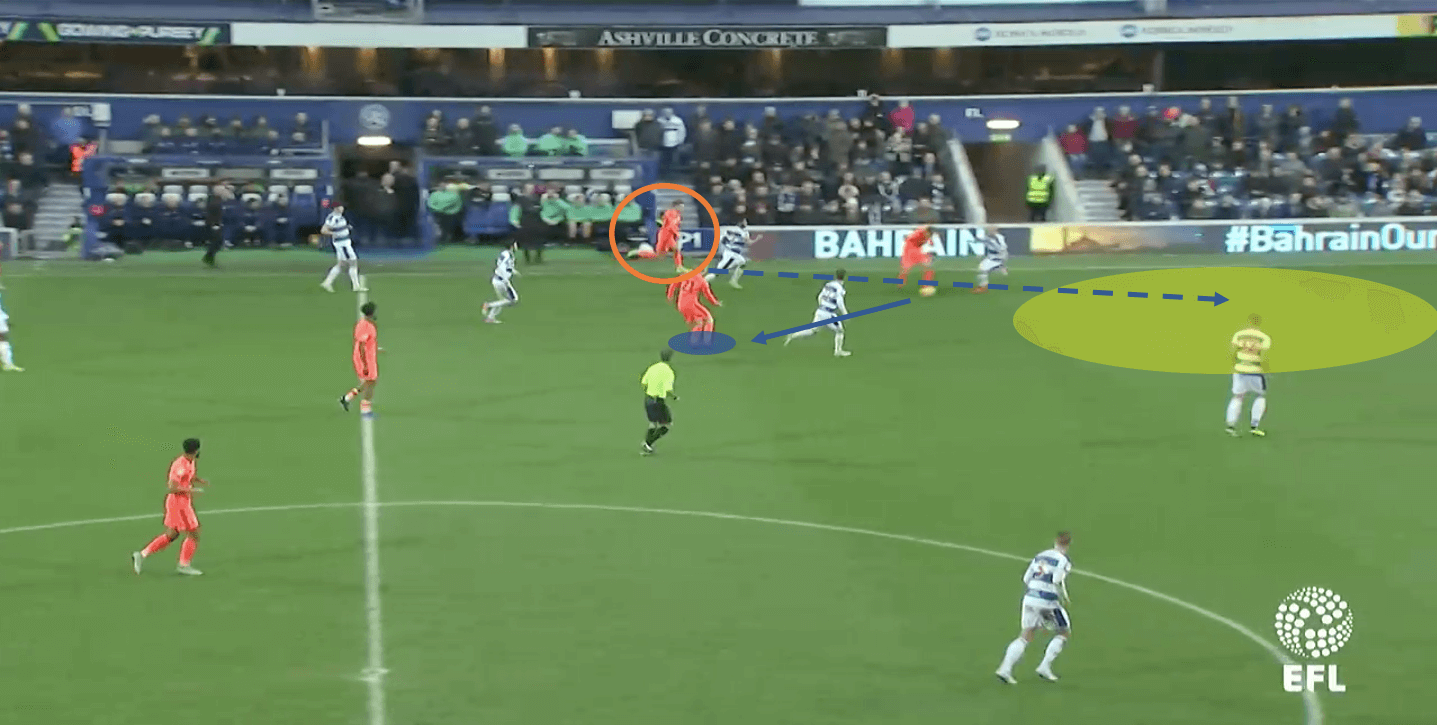
In an almost identical example, Downes again exploits the space left in a wide-channel to find his teammate breaking in behind a high QPR defensive line.
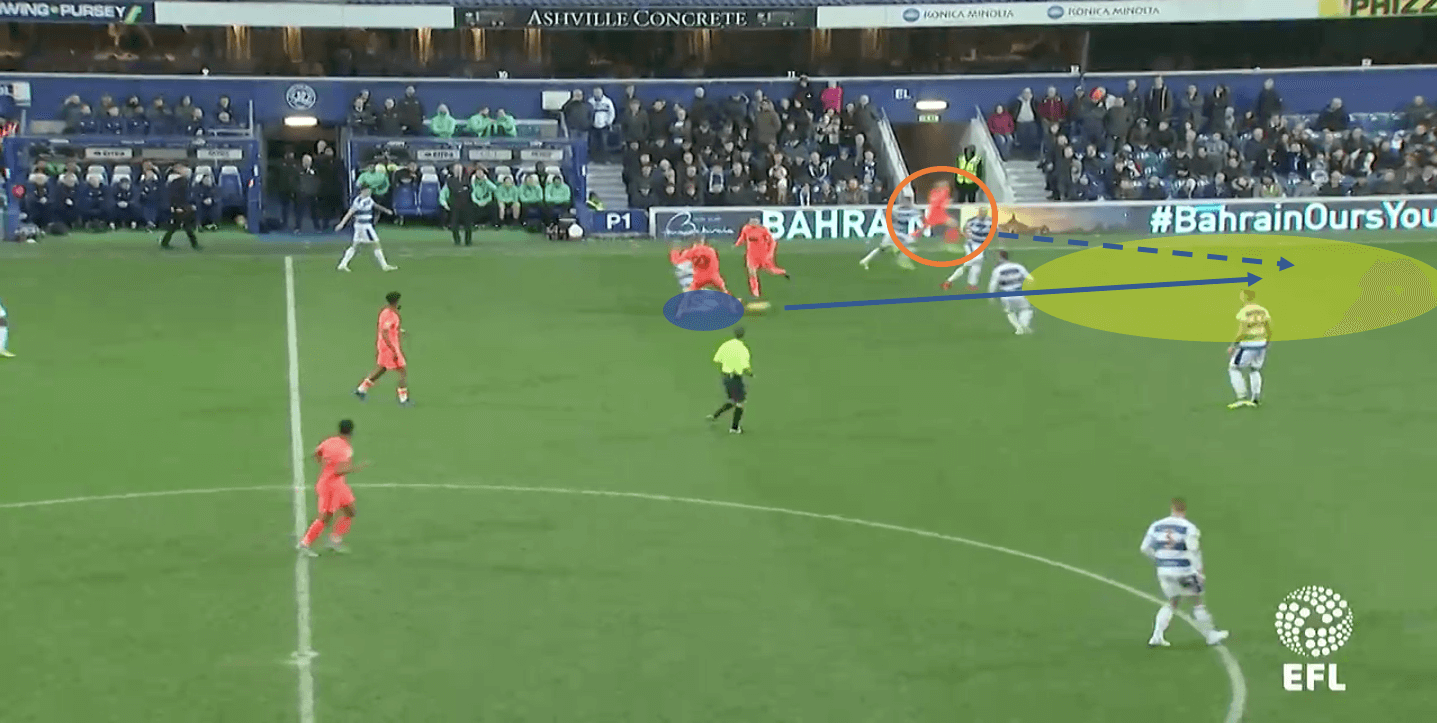
The two above examples highlight both Downes’ vision to spot third-man runs but also his impeccable timing and weighting of the pass.
Flynn Downes’ best work comes against opposing defences when they are unorganised or disjointed.
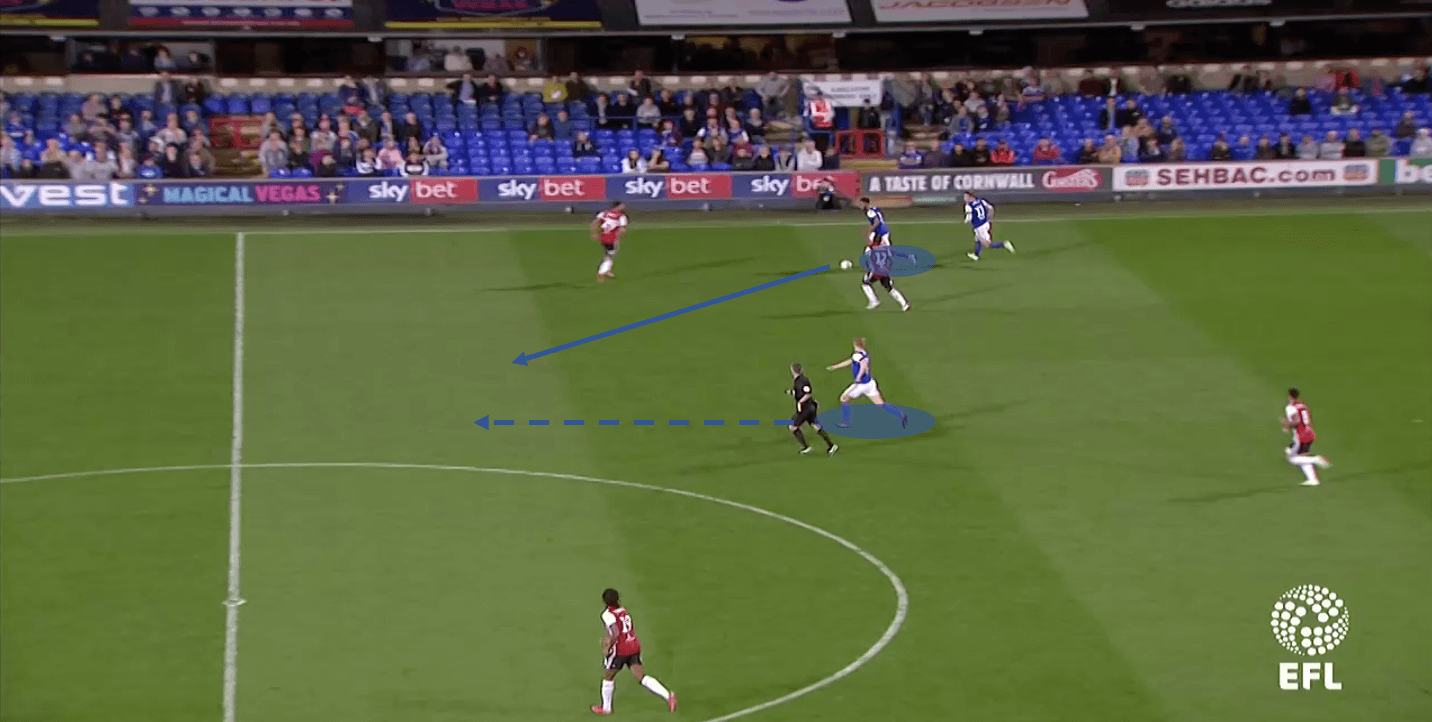
In the example above we can see Ipswich are in transition. Downes’ teammate is carrying the ball and he identifies space ahead of him and signals to his teammate where to play the pass.
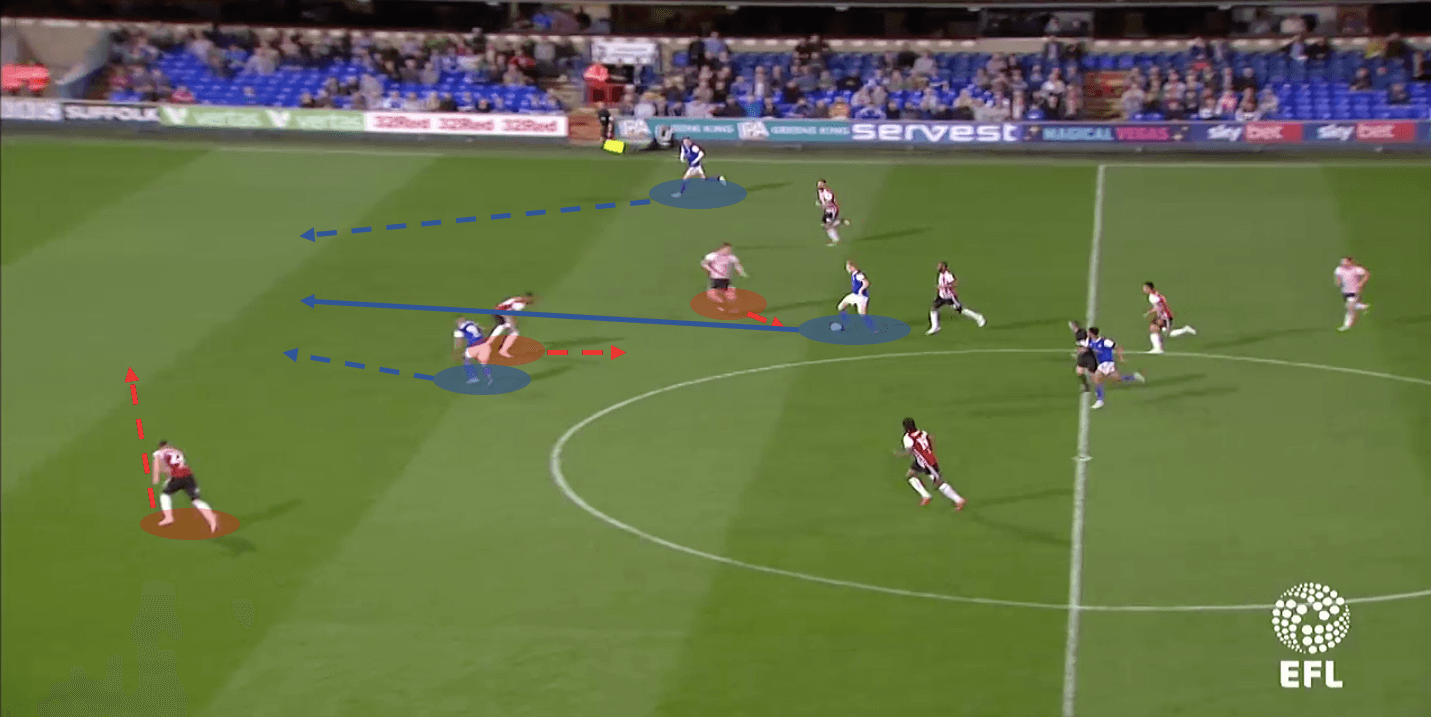
Once Downes’ receives the ball in a dangerous position the opposing defenders are forced to apply pressure on him. He is closed down quickly by two players but he has spotted the space in behind the back four and plays a quick and perfectly weighted pass for the centre-forward to run on to.
Despite looking most at ease against disjointed defences, Flynn Downes also has the ability to break through an organised defence.
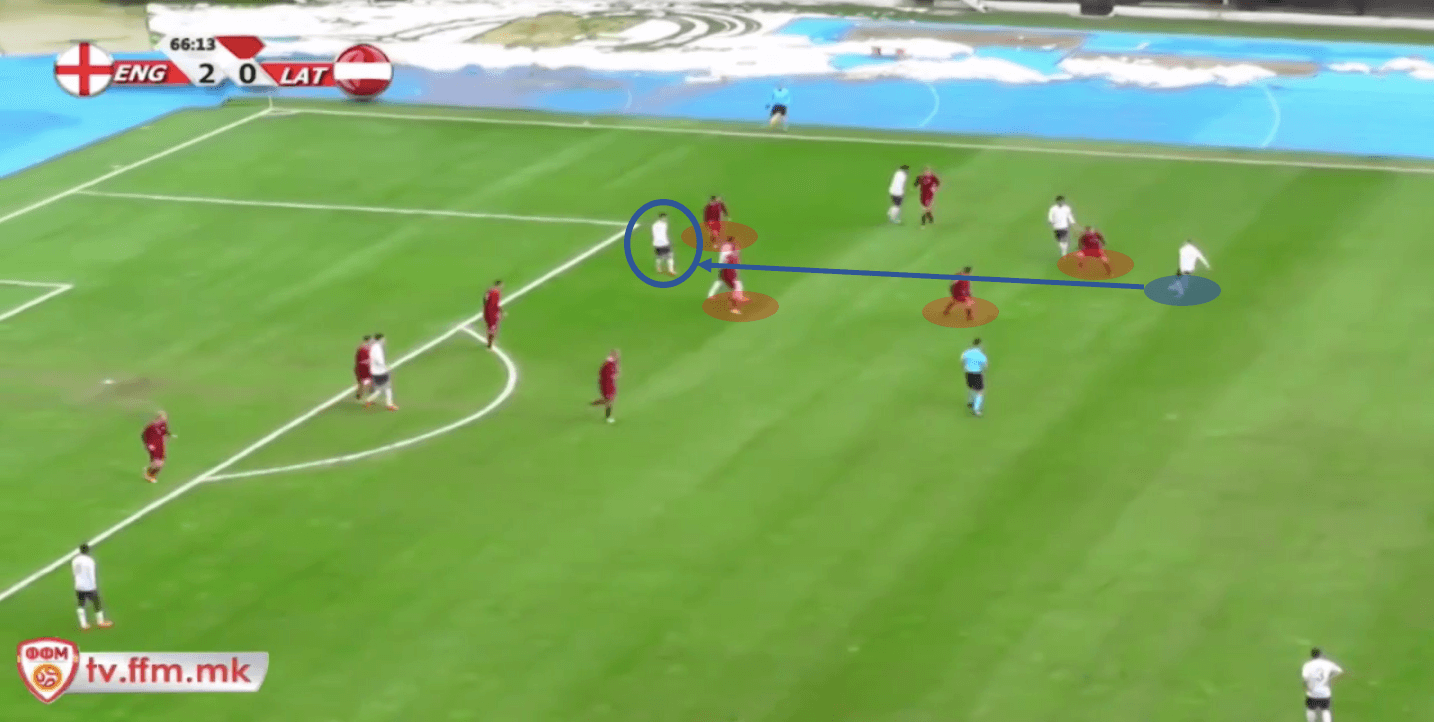
The above example is taken from an England U20’s game against Latvia. Downes has possession of the ball on the edge of Latvia’s final third. The Latvian defenders are in a reasonable defensive structure and with Downes on the ball in the position he is in there is no obvious immediate danger. However, using a teammate as a decoy, Downes’ threads a neat through ball to the circled forward which cuts through four Latvian players presenting his team with a clear chance on goal.
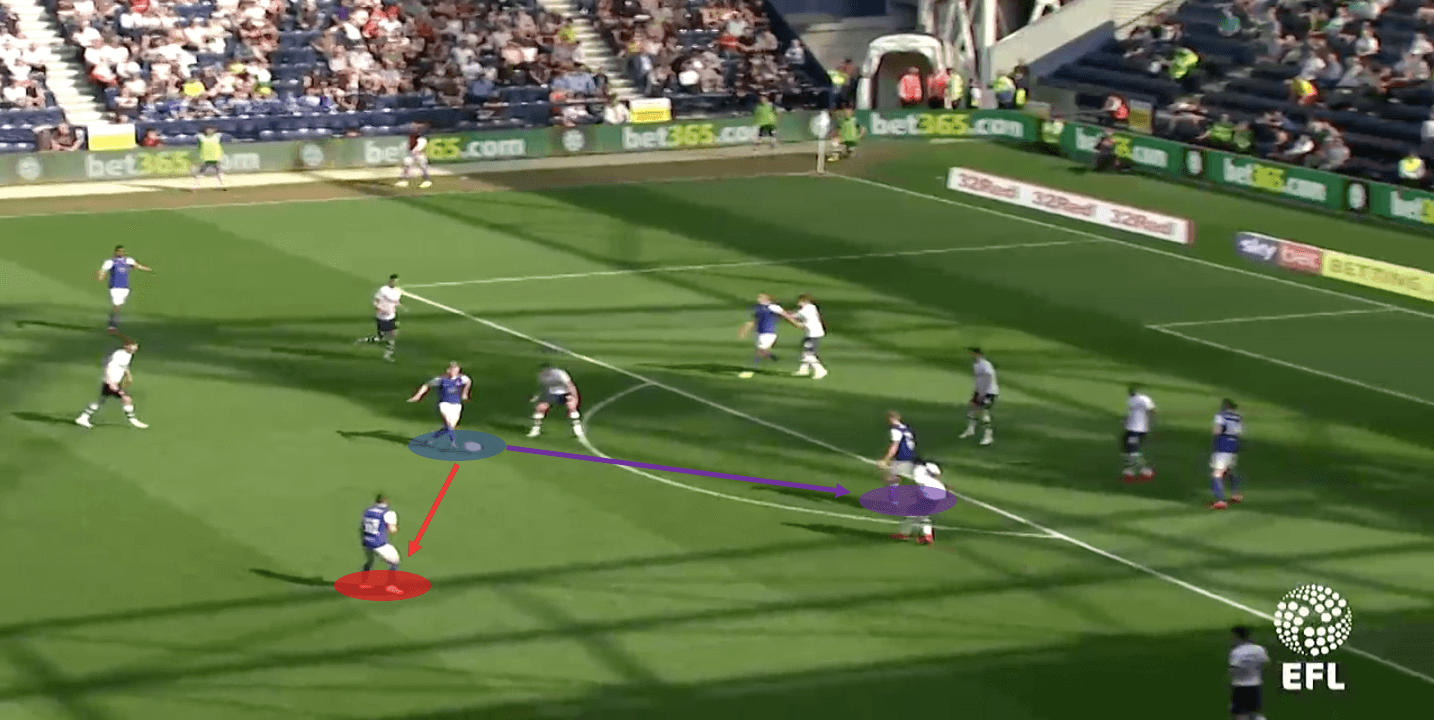
A slightly less flashy example is shown above as Downes has the ball on the edge of Preston’s box. The simple and risk-free pass for Downes would follow the red arrow which would circulate possession. The riskier but more positive pass is along the purple arrow to his teammate position between the midfield and defence right outside the box. Downes chooses the purple pass which presents Ipswich with a 2v2 just inside the Preston box. The ball is shifted to the striker on the right of the purple player and he has a clear shot at goal. Had Downes chosen to pass along the red line then the chance would have been lost.
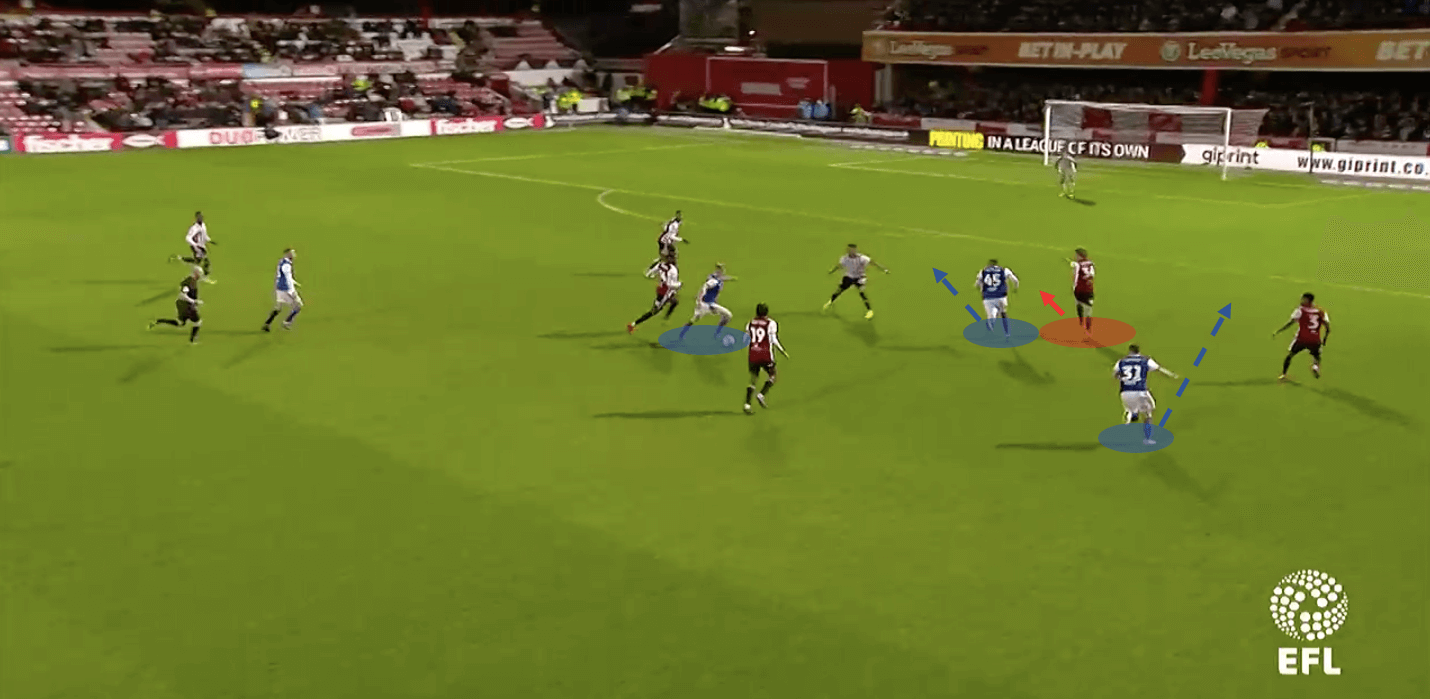
Another example is shown above which I feel encapsulates a lot of Flynn Downes’ ability on the ball. He is carrying the ball into the final third with a lot of movement ahead of him. Ipswich’s number 45 is making a run from right to left which drags one of the Brentford defenders slightly out of position opening up space inside the left-back.
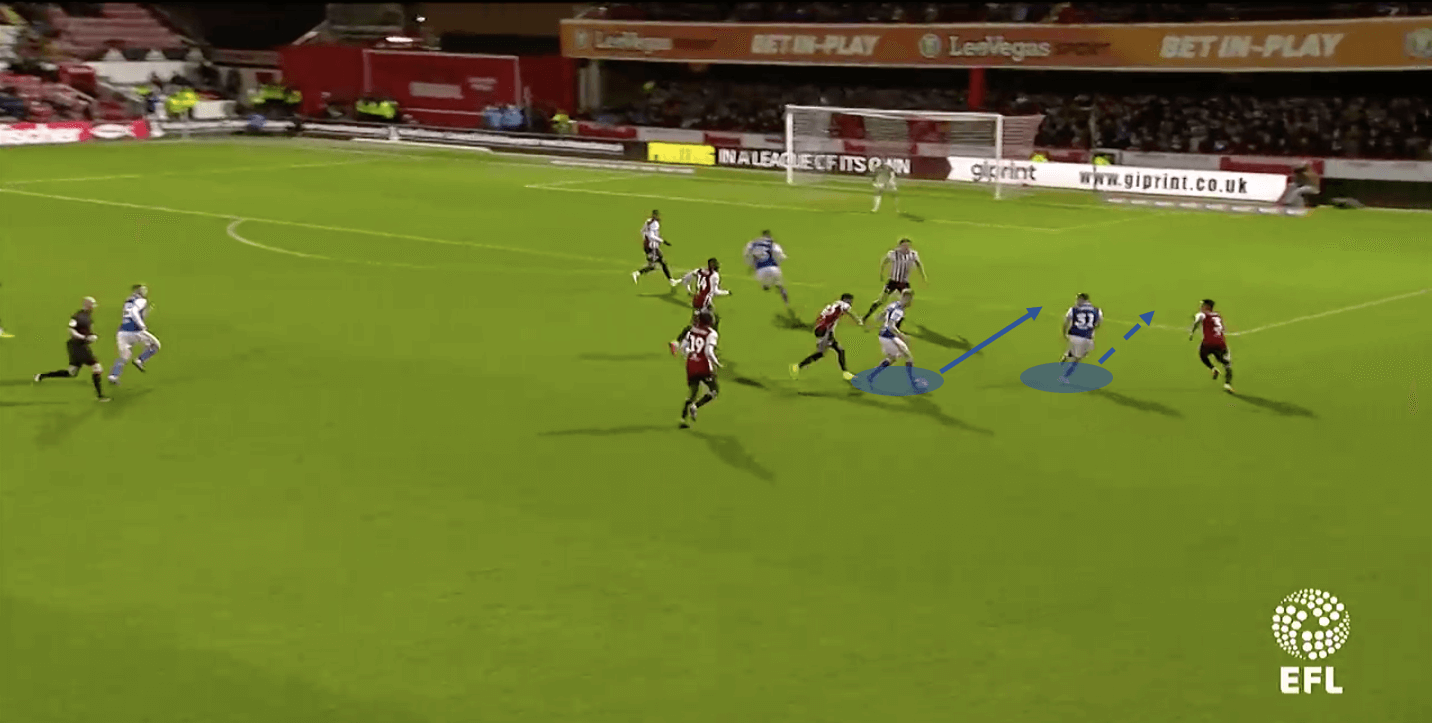
Downes uses the strikers run as a decoy and holds onto the ball for just long enough to allow his teammate to get inside the left-back before releasing a perfectly-weighted through ball for him to run on to. Unfortunately, his shot is blazed over the bar.
All of the examples shown thus far has been short five to 10 yard passes, but Flynn Downes has also shown this season that he can at times play accurate 40-50 yard passes into space.
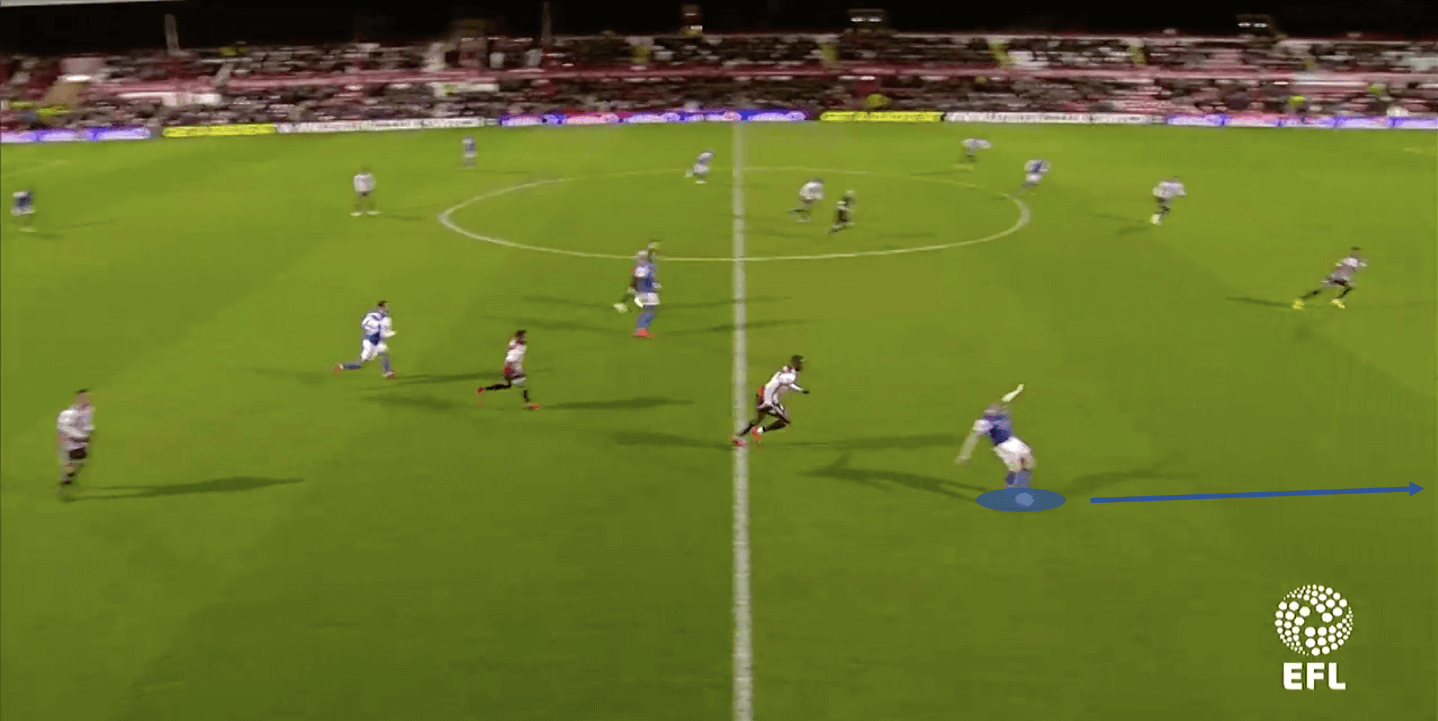
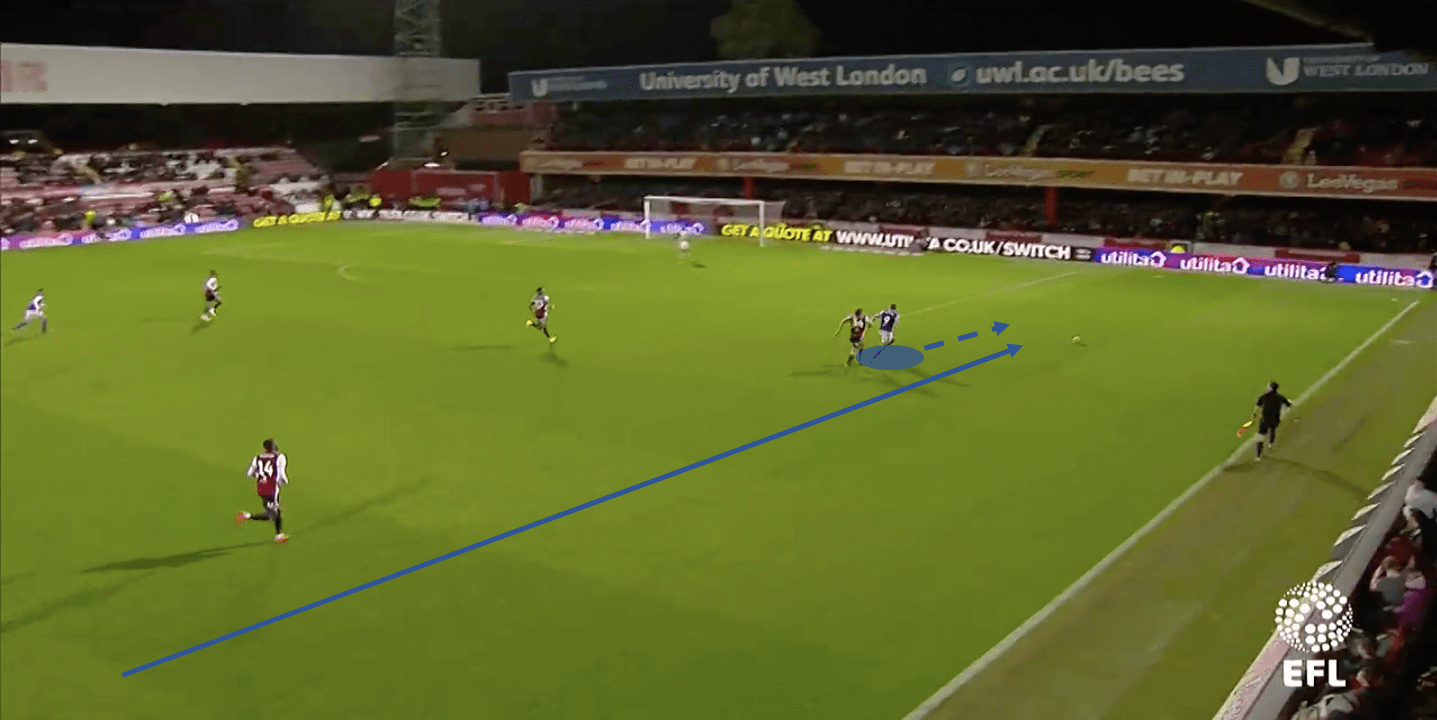
Again from the game against Brentford, Downes finds an inch-perfect pass down the line for his teammate to latch onto behind the defence.
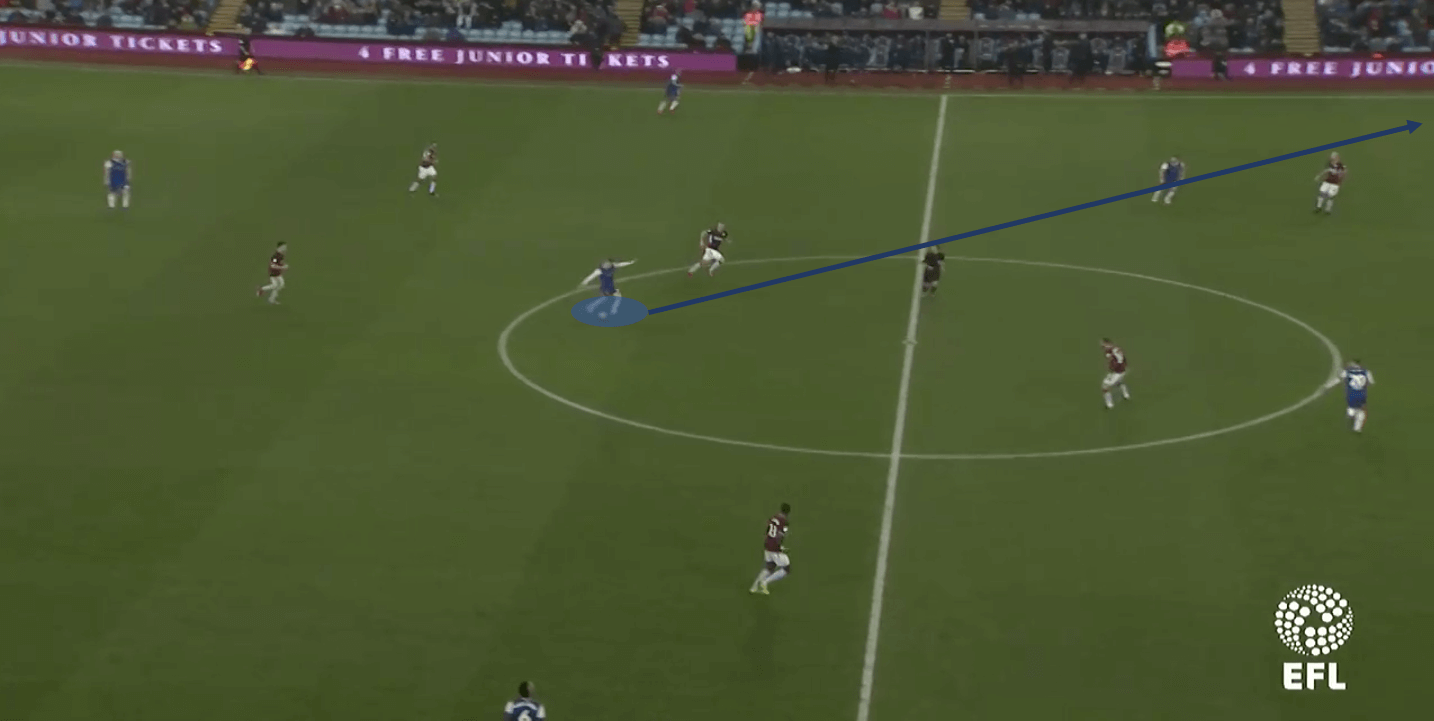
His most impressive long pass came against Aston Villa when Flynn Downes picked the ball up inside his own half before turning the Aston Villa player who was pressurising him from behind. He gets his head up and plays a long, straight ball over the top of the Villa defence.
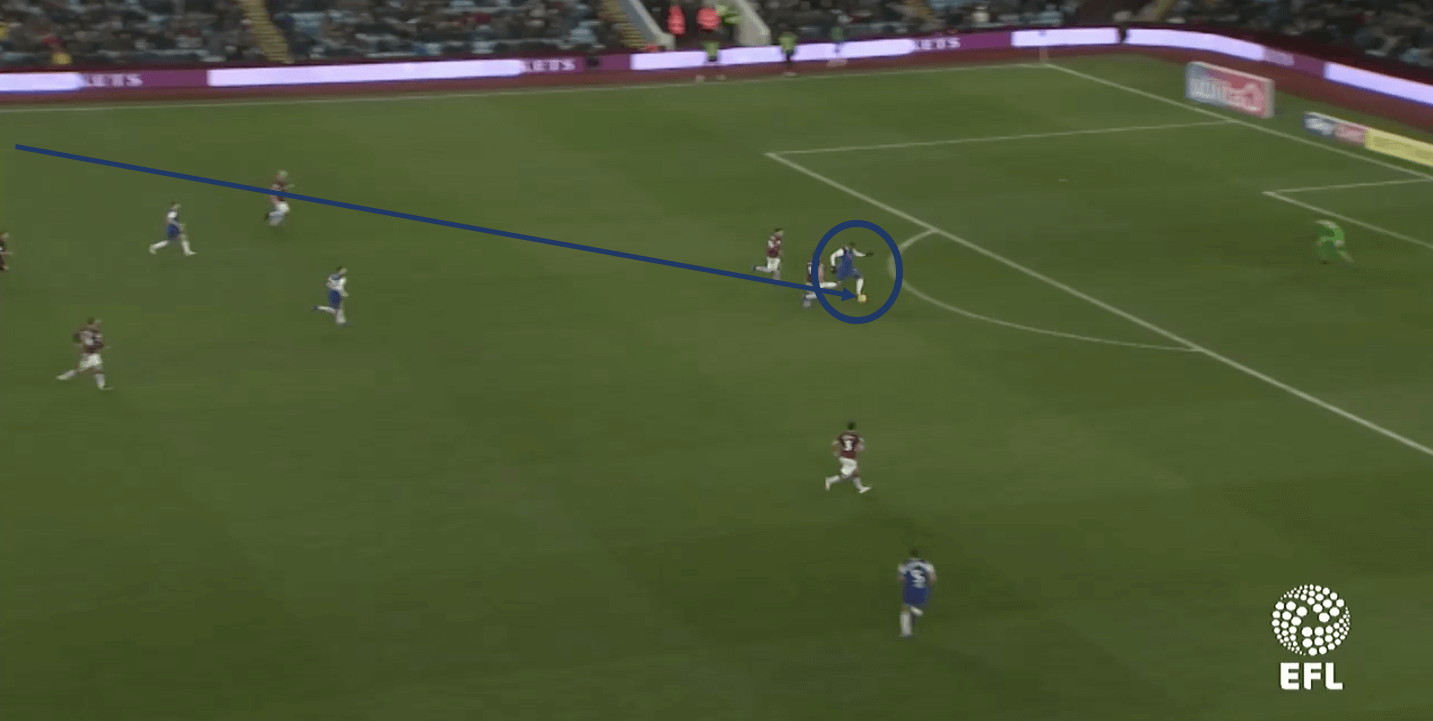
The ball lands on the toe of the Ipswich forward who takes it around the keeper before the shot is blocked by the arm of an Aston Villa defender.
Flynn Downes does have these kinds of passes in his arsenal as highlighted above, however, he is often inaccurate and surrenders possession when he plays them.
Downes himself is yet to offer much of a direct goal-threat for his side. If he is able to replicate the kinds of run he displays in the example below then this could add another dimension to his game.
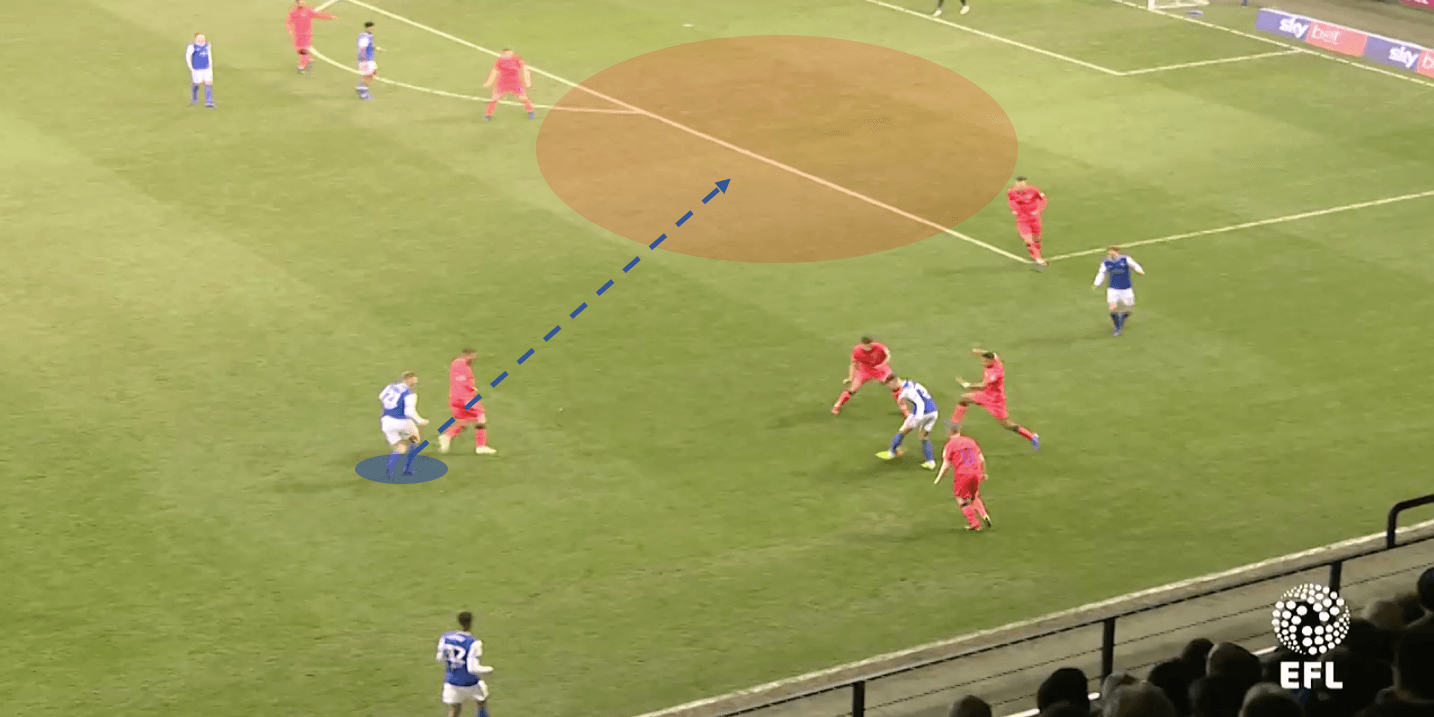
As play is developing on this near-side, Downes spots the space appearing in the opposing backline as the left-back is dragged out wide.
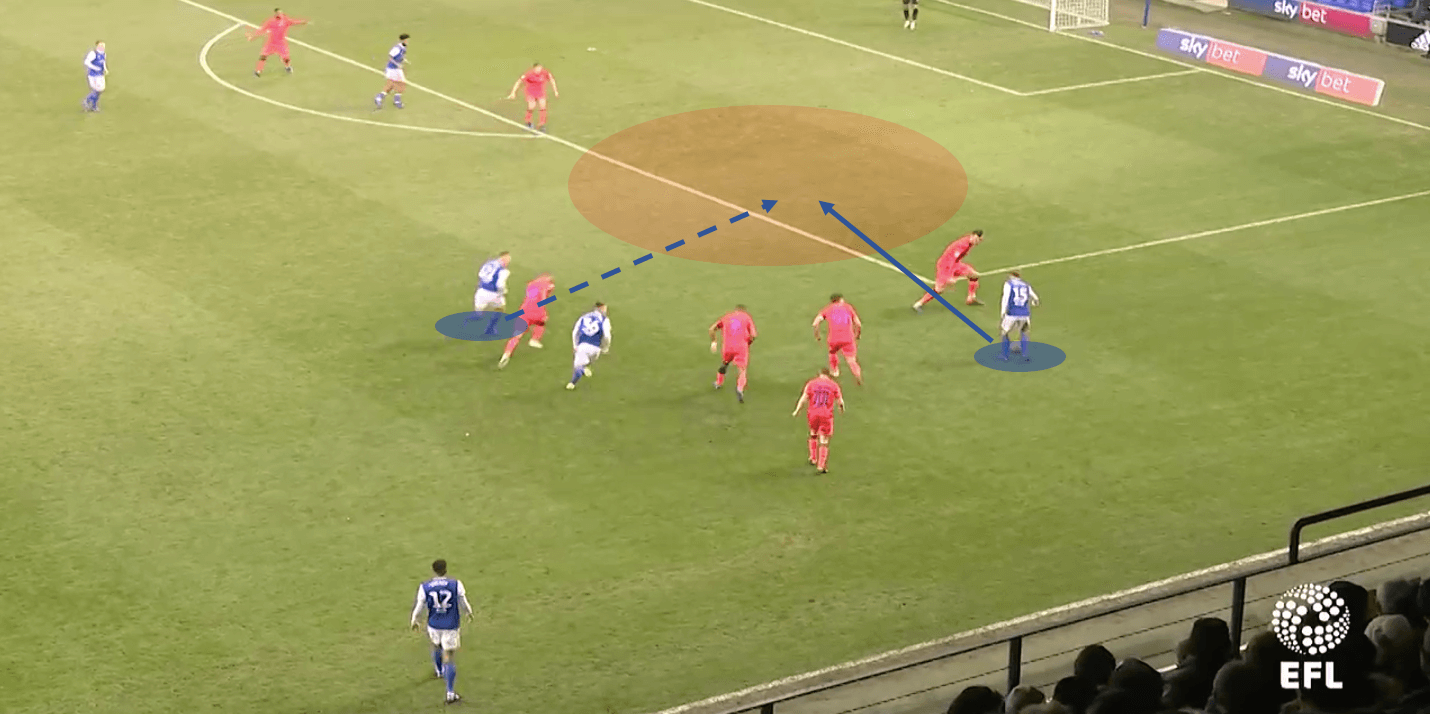
Given his early identification of space, Downes is able to get the run on his marker and break into the box somewhat untracked.
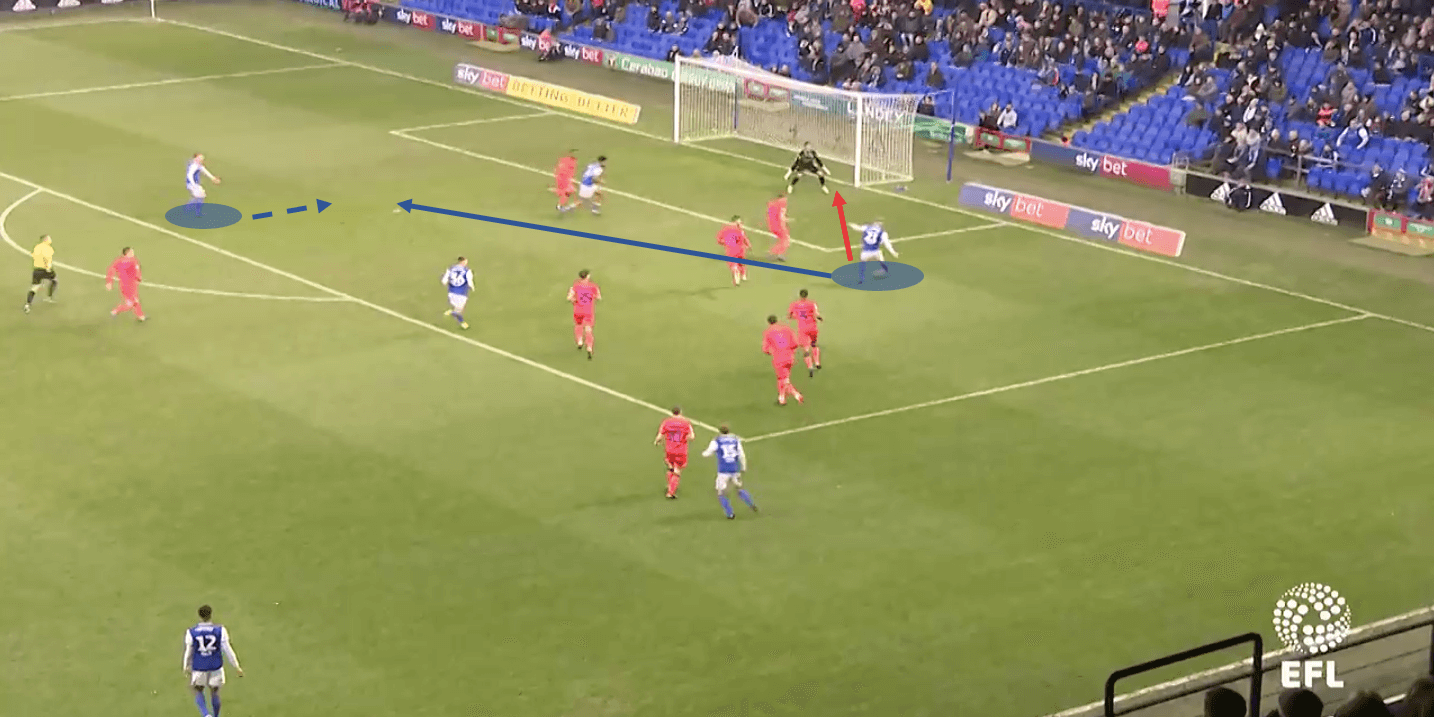
When Downes receives the ball he is presented with two options. He could strike at goal but this is from a fairly narrow angle and the goalkeeper is well set and in a good position to stop the shot. His second and probably better option is a pull-back towards the penalty spot where a teammate is unmarked and has all the goal to aim at. Downes chooses to pass the ball and it takes an incredible block from the opposition defender to prevent a near-certain goal.
Without the ball
Given the fact that Ipswich finished bottom of the table, conceding 77 goals in the process, Downes would have been expected to spend a lot of his time defending. Flynn Downes wins 19.29% of his defensive duels, ranking him 73rd for central midfielders with over 1500 minutes in the division. He wins 38% of his aerial duels ranking him 72nd in the division and makes 3.94 interceptions per 90 which ranks him 71st. These numbers are reasonable for a midfielder whose main strengths appear to be in the final third. What stood out when watching Downes last season is that he has an impeccable work rate and appreciation for his role in the side.
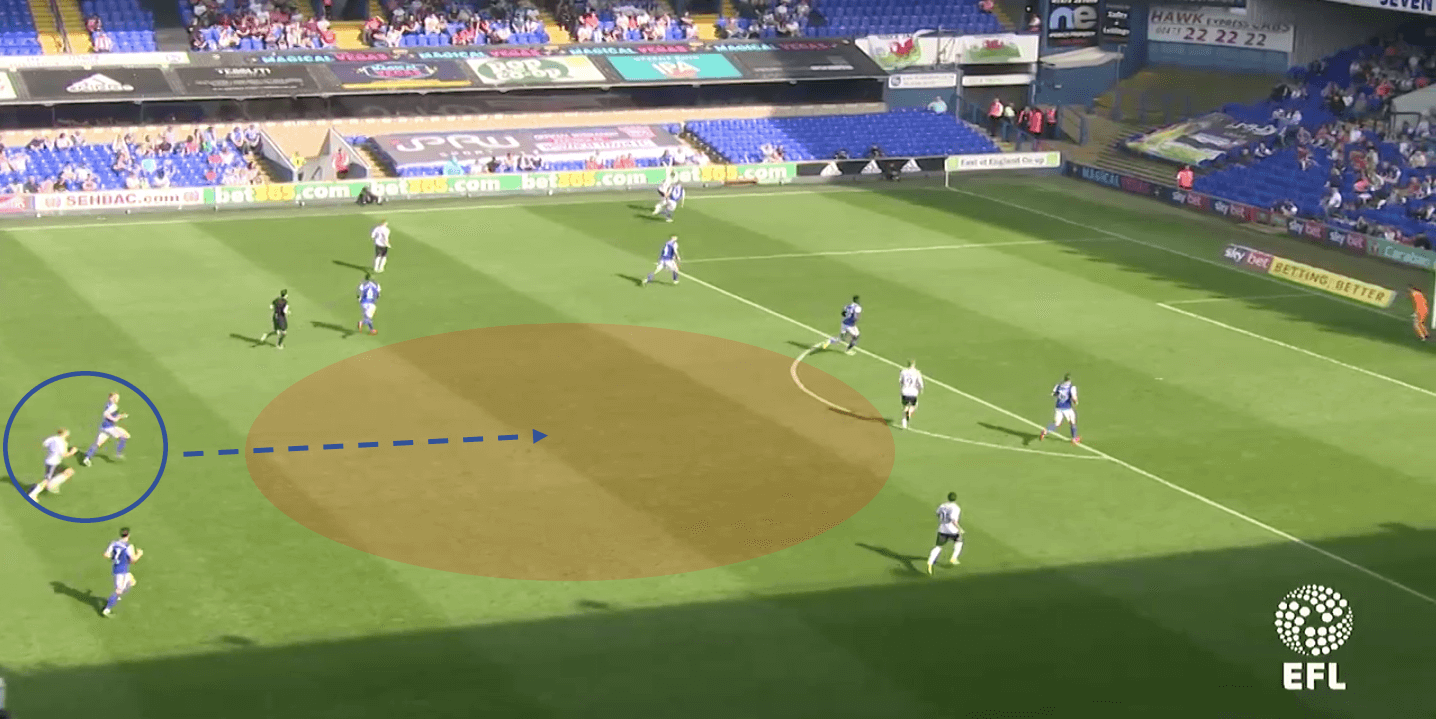
In the image above there is a sizeable hole between the Ipswich midfield and the defensive line as the opposition are attacking. Downes is making his way back to fill the space but also has his head on a swivel to assess where the danger is. He notices the onrushing midfielder and tracks his run and blocking his line to the ball.
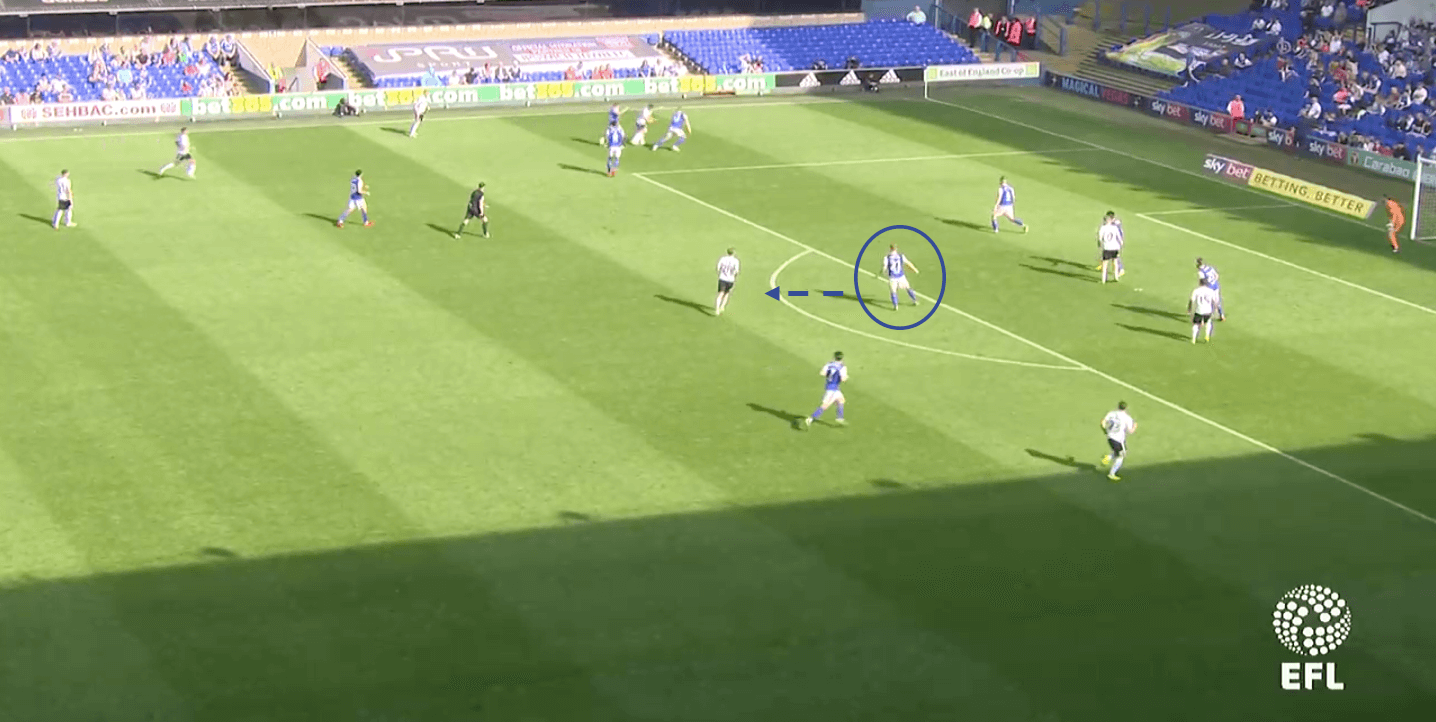
Downes tracks his man back to the edge of the box and has positioned himself well to prevent the immediate danger. He keeps close to his man but has a good body shape so as to adjust quickly to whichever kind of ball comes into the box.
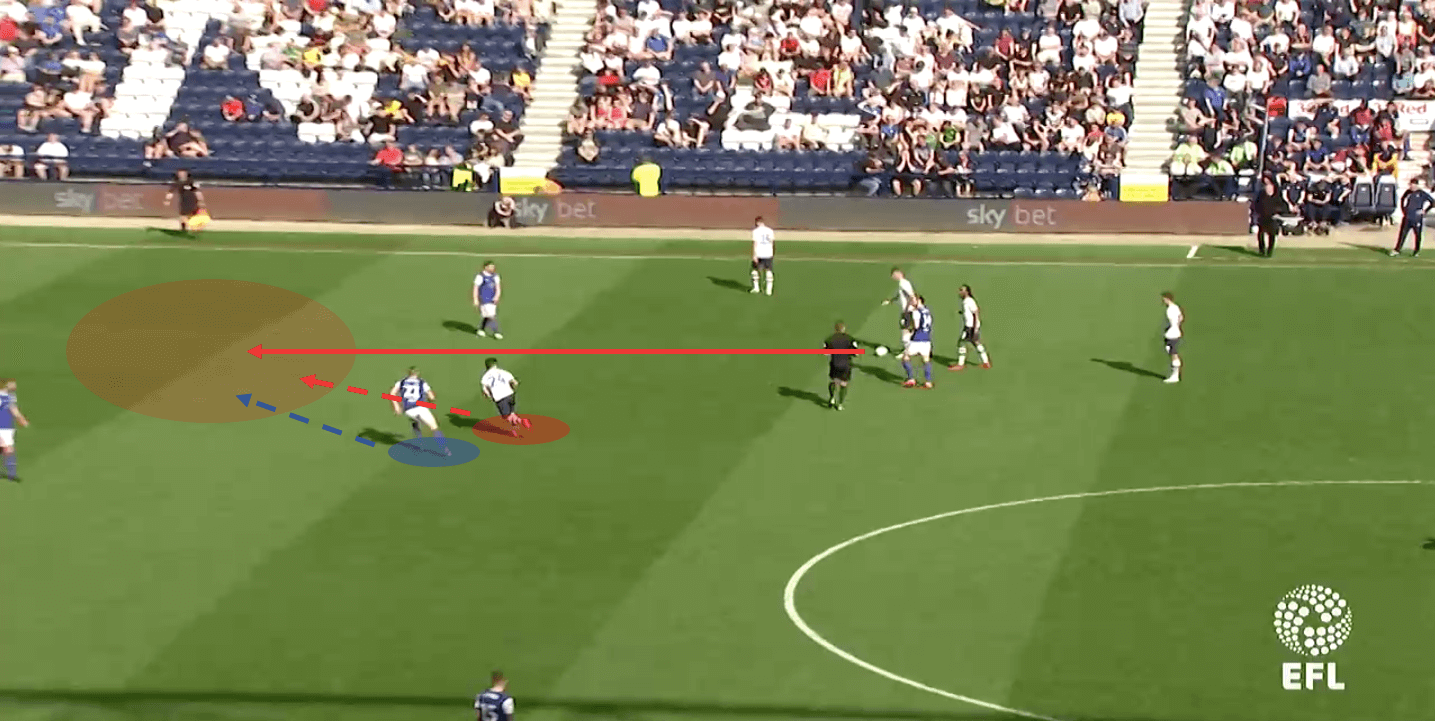
His anticipation of danger is a key aspect of his defensive contribution to his team. In the image above, the opposition are looking to take a quick free-kick. A number of Downes’ teammates are not set for the free-kick but Downes himself anticipates the movement forward by the opposition midfielder and tracks his run. Downes is able to follow the ball through and makes the interception, clearing the ball from danger.
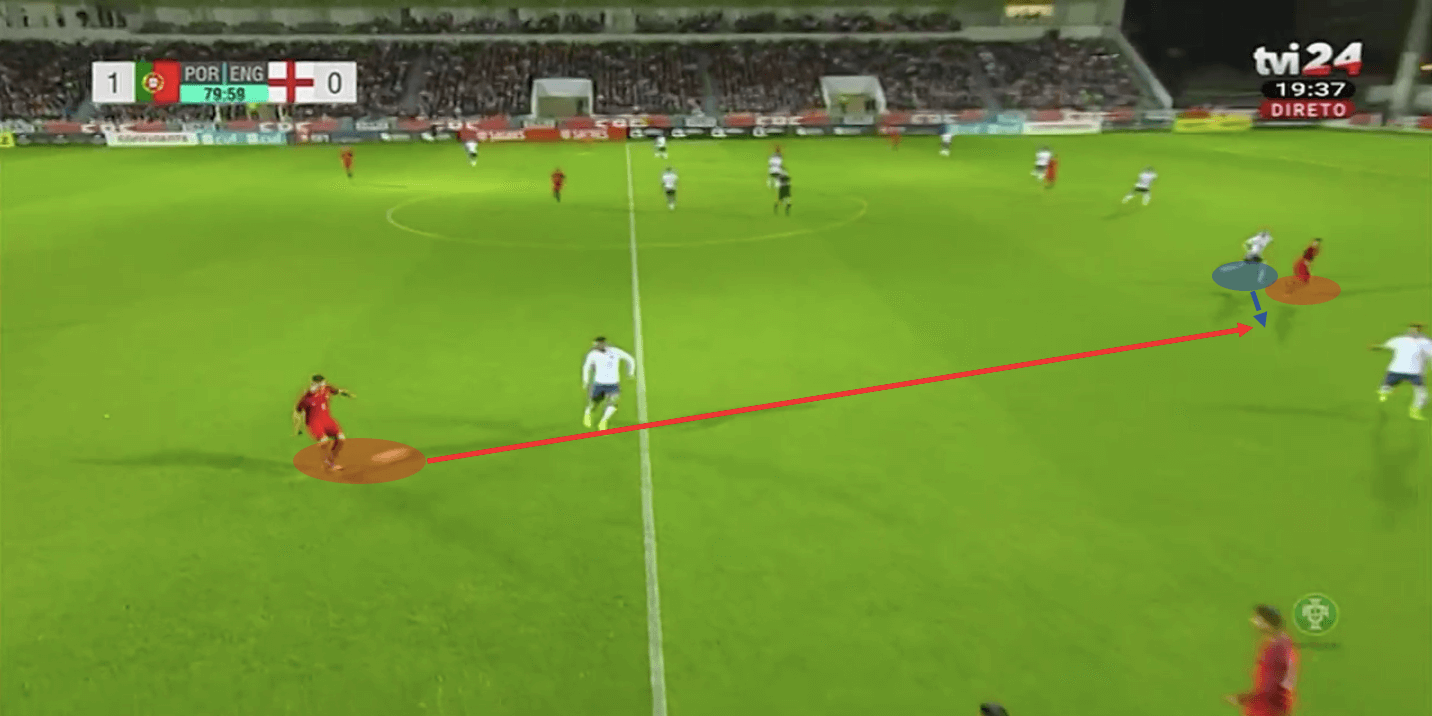
Flynn Downes’ defensive anticipation is again on show in an England shirt in the image above. The Portuguese defender is looking to progress the ball into the feet of his attacking teammate. Downes has dropped back into the back four and is looking to jump in front of the attacker and make the interception.
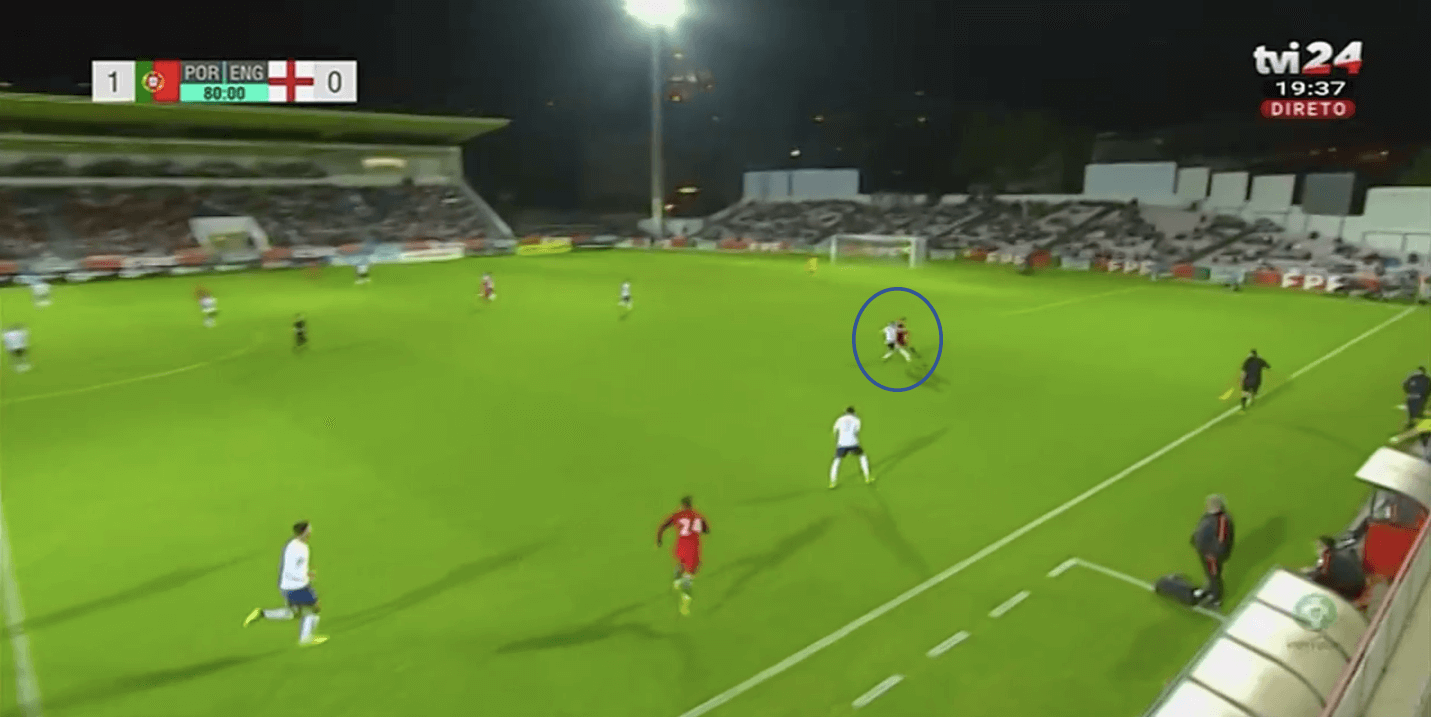
As the pass is played forward Downes nips ahead of the Portuguese attacker, getting a toe in and laying the ball off to a nearby teammate. This composure that Downes shows when he has won the ball back for his side is also a huge asset to his game.
In the below image, Brentford have got themselves in behind the Ipswich midfield line and are in an attacking transition and looking quite threatening. The Brentford player with the ball in the centre circle is laying the ball off to his teammate who is breaking forward. Downes is a good four or five yards off his man but he is able to make up the difference and make the interception.
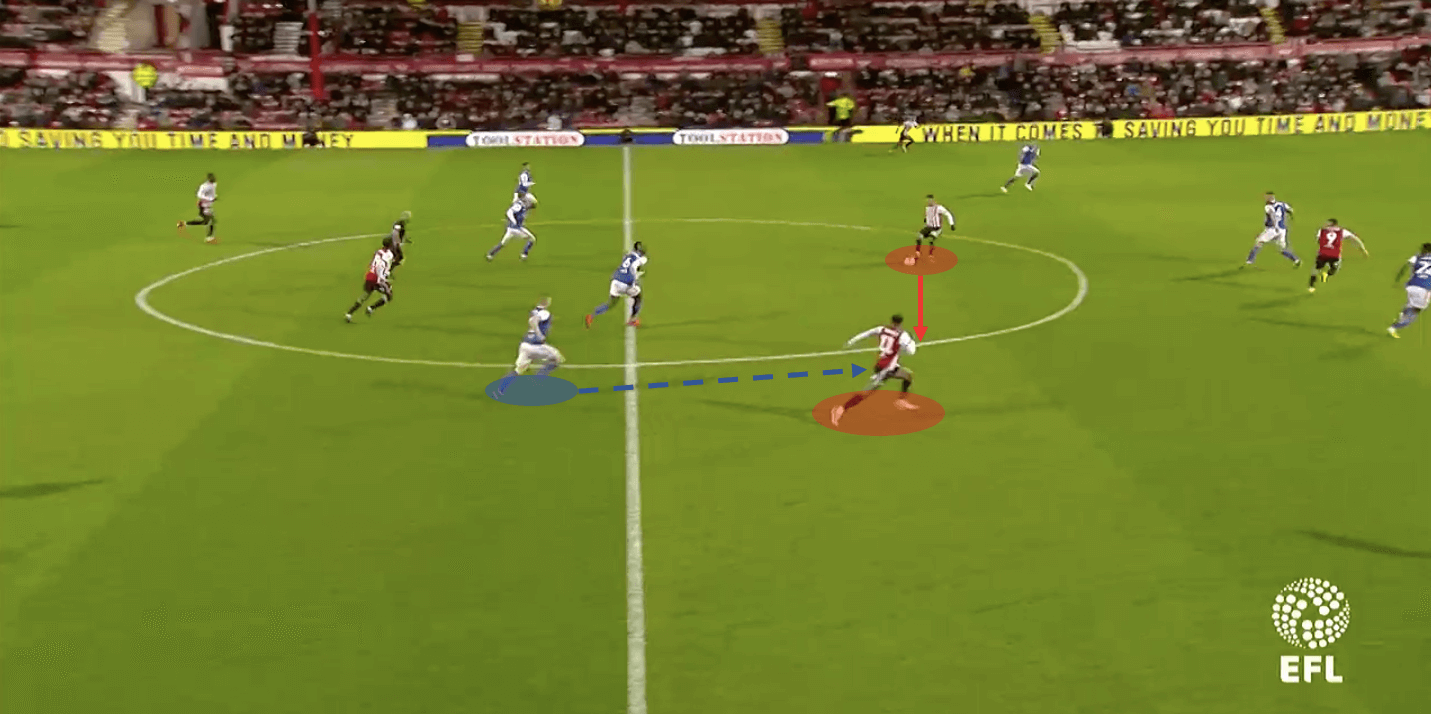
Facing his own goal he calmly lays the ball off to Myles Kenlock.
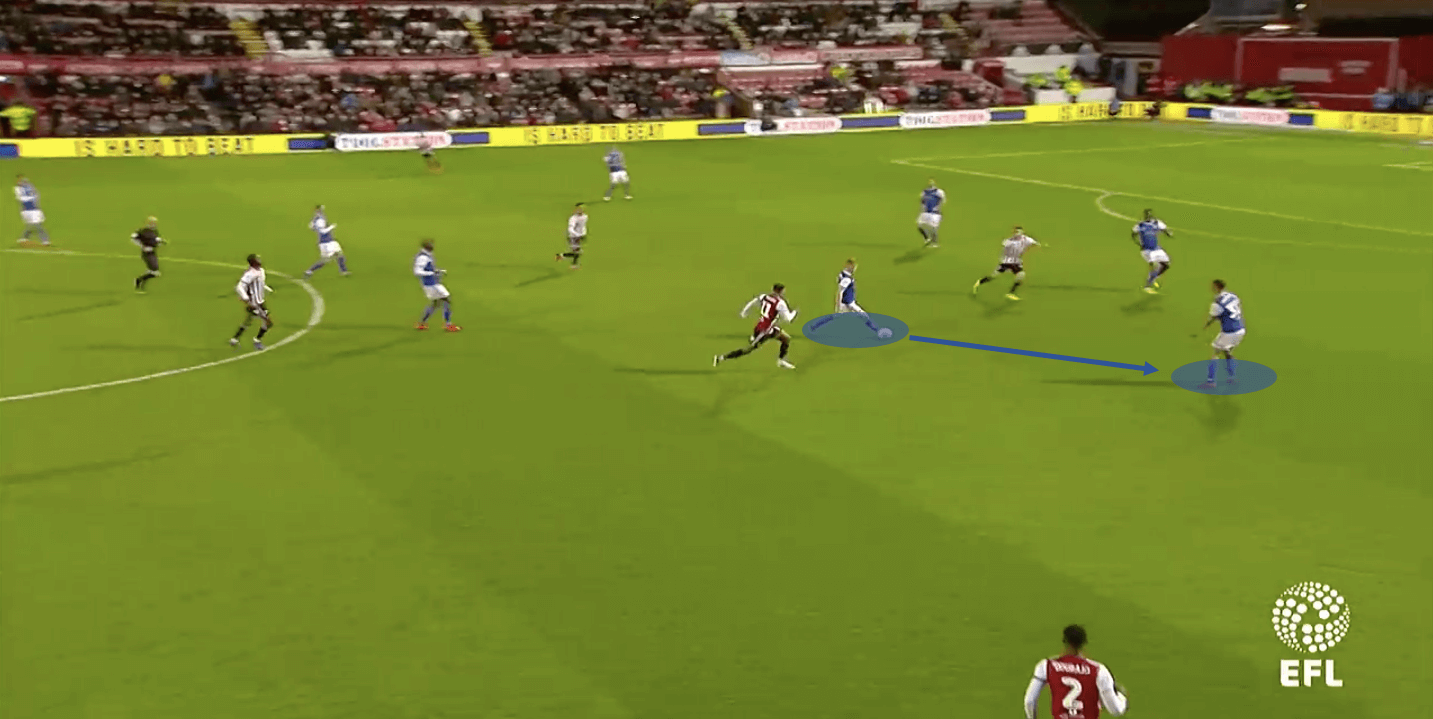
Kenlock lays the ball back to Flynn Downes, who then plays the ball back to Kenlock who dribbles past the number two for Brentford. Due to Downes’ anticipation and composure Ipswich have turned defence into attack in just three passes.
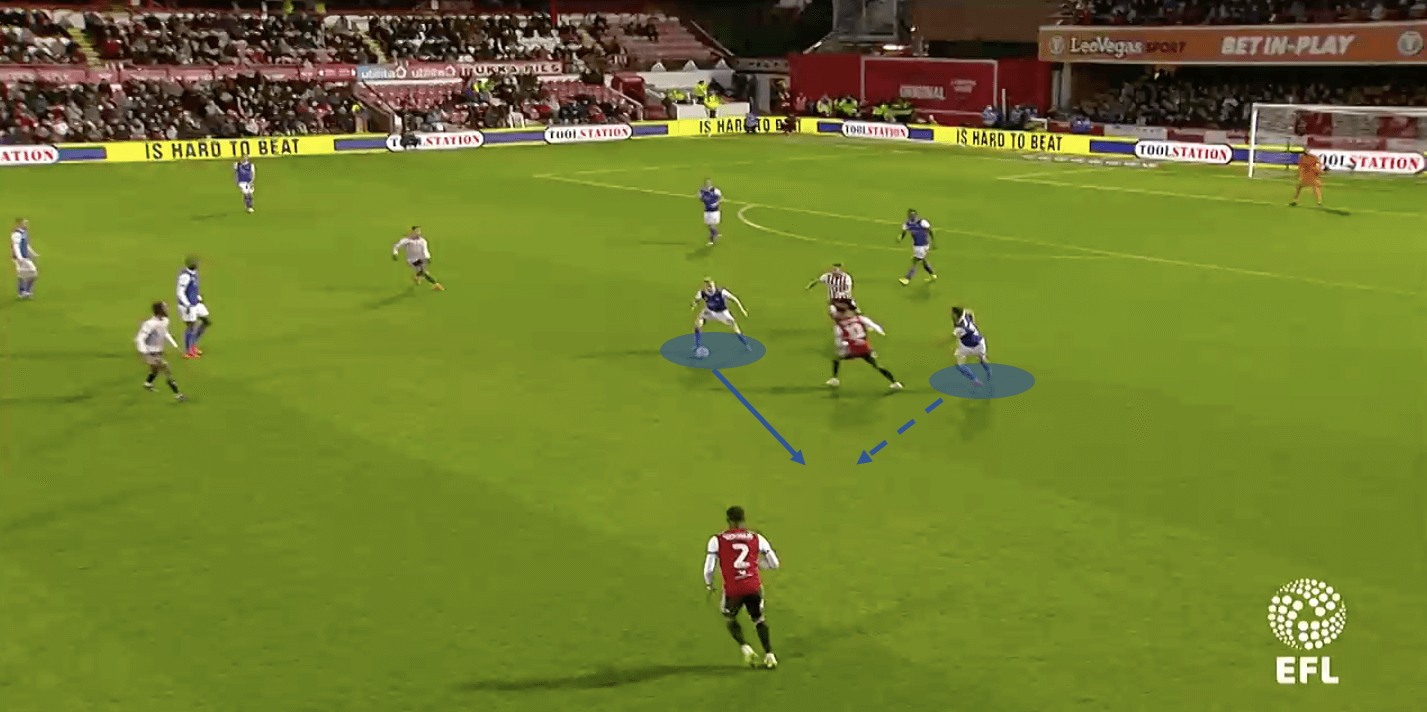
Flynn Downes’ defensive work rate is his biggest strength when it comes to his work off the ball, however, his defensive positioning can sometimes be left wanting.
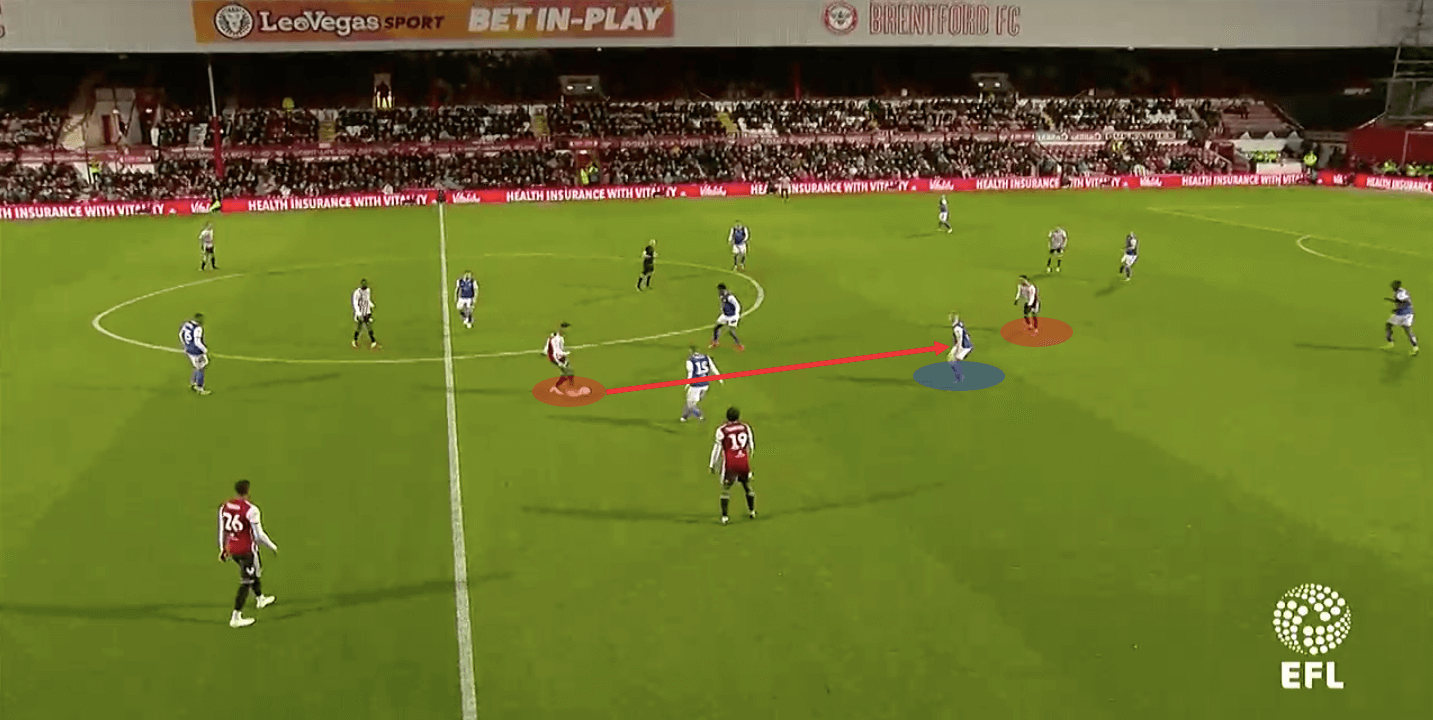
In the image above Ipswich are set in their defensive structure. Flynn Downes, highlighted in blue, has found himself somewhat in no-mans-land. He is neither applying pressure to the ball carrier or covering the man behind him who is in a threatening position. His defensive awareness here is letting him down and presenting a problem to his team. One could argue that the team’s nominated defensive midfielder Trevoh Chalobah should be the one covering this position but as he is pressurising the ball carrier, Downes must adapt and cover his teammate.
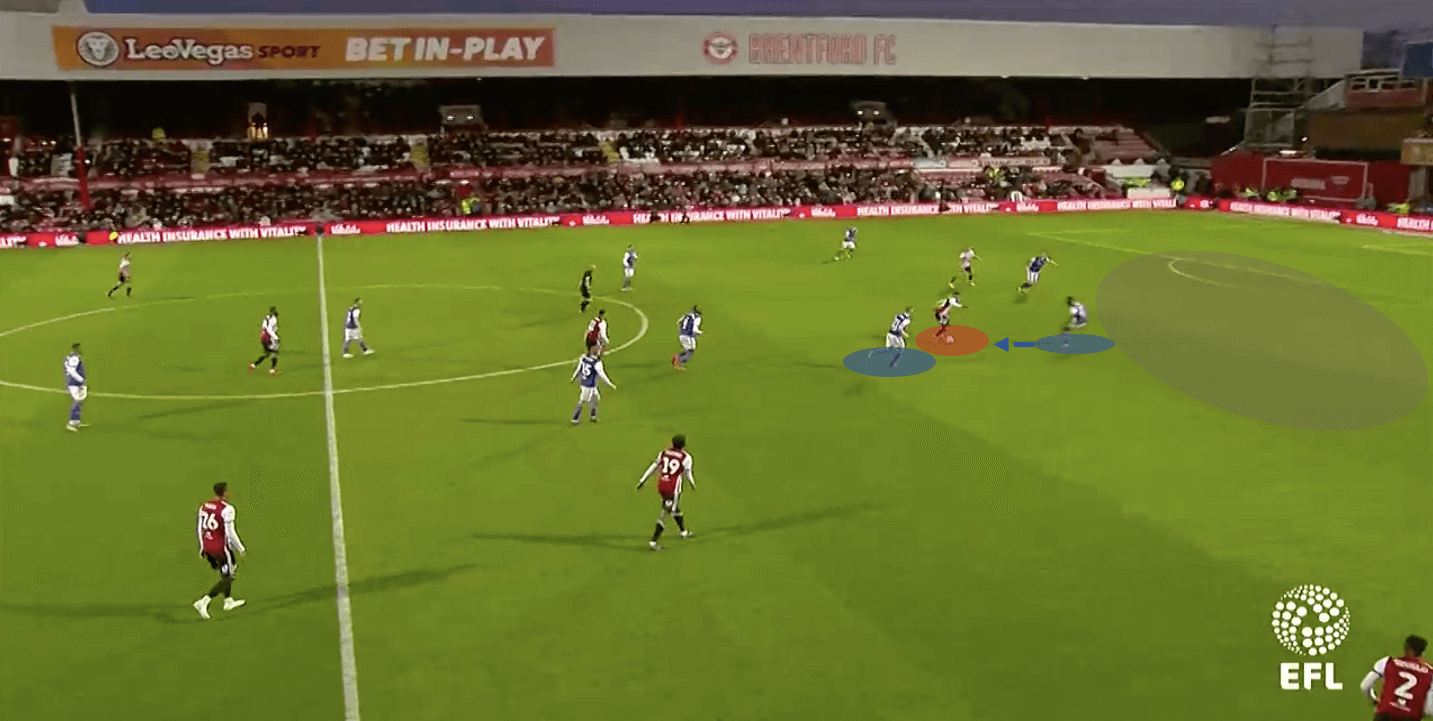
The ball is easily played into the Brentford midfielder who receives the ball and turns. This forces the Ipswich centre-back to move out of the defensive line. He is easily beaten and Brentford find themselves in a 2v1 situation on the edge of Ipswich’s box.
Conclusion
Flynn Downes is an exciting young player who despite playing for the worst side in the division last season showed his formidable potential. Given Ipswich’s relegation, it will be interesting to see whether Paul Lambert sticks with his young guns and trusts them to guide the team back to the Championship. If Lambert does stick with the likes of Downes, Dozzel and Kenlock then it would be a huge sign of faith in a good batch of young players.
Whilst Downes does have some clear positive aspects to his game, such as his vision, weight of pass, anticipation of danger and work rate, there are other aspects of his game that must be improved if he is to work his way up the leagues. He perhaps needs to improve his physicality, this may come naturally as he grows and ages, particularly when playing in a physical league such as League One. His defensive positioning when his side are in a low/medium block could also do with some work. This is likely to improve with greater experience in the side and a full season under Paul Lambert and his tactics.
If you love tactical analysis, then you’ll love the digital magazines from totalfootballanalysis.com – a guaranteed 100+ pages of pure tactical analysis covering topics from the Premier League, Serie A, La Liga, Bundesliga and many, many more. Buy your copy of the June issue for just ₤4.99 here, or even better sign up for a ₤50 annual membership (12 monthly issues plus the annual review) right here.

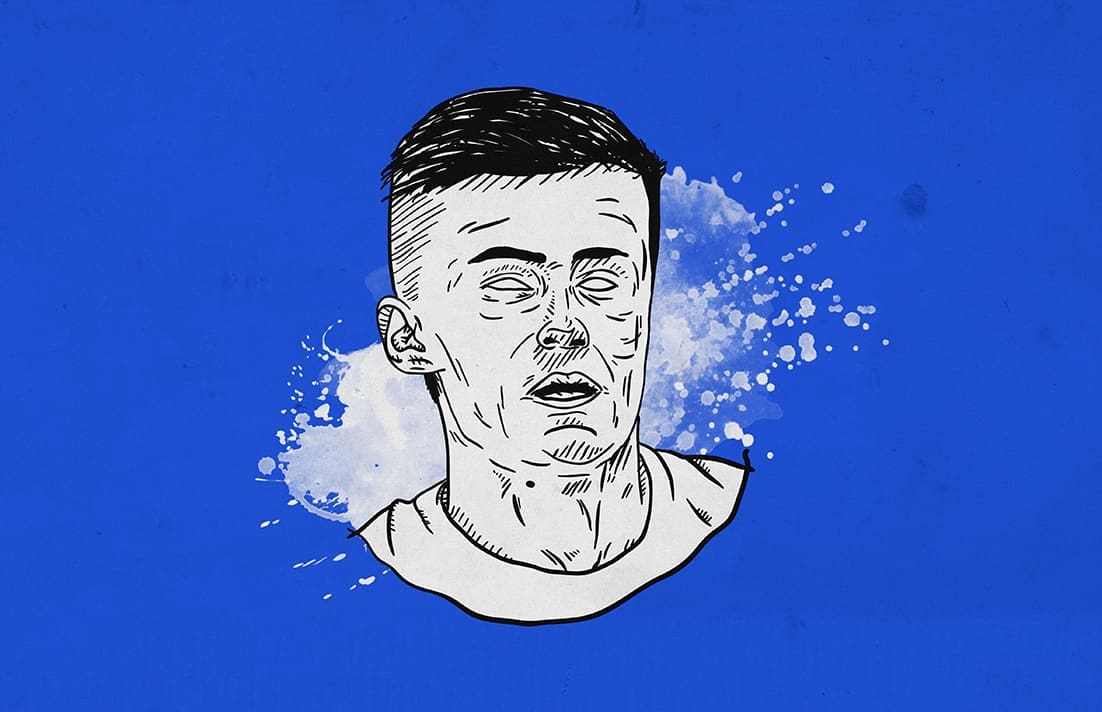



Comments